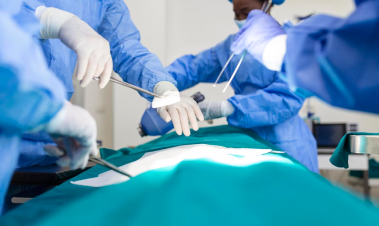Best Laparoscopic Surgery in Delhi at Saroj Super Speciality Hospital
Laparoscopic surgery has become a ground-breaking method that has transformed surgery in the world of contemporary medicine. This minimally invasive procedure has gained widespread popularity and acceptance due to its numerous benefits over traditional open surgeries. With its precision, minimal scarring, reduced recovery time, and improved patient outcomes, laparoscopic surgery has become a cornerstone of contemporary surgical practice. The complexities of laparoscopic surgery are examined in this article, along with its definition, method, benefits, and uses.
Types of laparoscopic surgeries
-
Diagnostic laparoscopy: This treatment identifies and pinpoints the origin of several medical disorders by visually inspecting the organs in the abdominal cavity. It is often performed when other diagnostic tests are inconclusive.
-
Therapeutic laparoscopy: This surgery is applied to treat particular illnesses or ailments. It involves the removal of abnormal tissues, repair of damaged organs, or the performance of other therapeutic interventions.
-
Laparoscopic-assisted procedures: In some cases, laparoscopic surgery combines traditional open surgery. The laparoscope visualises the surgical field, while the actual surgical manipulation is performed through a larger incision.
Reasons for Laparoscopic Surgery
-
Minimally invasive nature: The small incisions used in laparoscopic procedures reduce trauma to the surrounding tissues, leading to less postoperative pain, minimal scarring, and faster recovery times compared to open surgeries.
-
Improved visualisation: The laparoscope provides surgeons with high-definition images of the internal organs, allowing for better visualisation of anatomical structures. This enhanced visual clarity enables surgeons to perform procedures with greater precision and accuracy.
-
Reduced risk of complications: Smaller incisions reduce blood loss, infection risk, and problems such as wound infections, hernias, and adhesions. Patients undergoing laparoscopic procedures often experience a lower overall risk of surgical complications.
-
Quicker recovery and shorter hospital stay: Patients who undergo laparoscopic surgery recuperate more quickly and with less postoperative pain thanks to the procedure's minimally intrusive nature. This results in shorter hospital stays and a quicker return to normal daily activities and work.
-
Wide range of applications: In addition to gastrointestinal procedures, gynaecological procedures, urological procedures, and thoracic procedures, laparoscopic surgery has found use in several medical specialities. Laparoscopic procedures are suited for a variety of problems due to their adaptability.
Preparation for Laparoscopic Surgery
Before undergoing laparoscopic surgery, proper preparation is crucial before laparoscopic surgery to ensure the best possible outcome and minimise potential risks. This preparation involves several essential steps, such as:
Medical Evaluation and Testing
Before laparoscopic surgery, a patient's overall health and fitness for the treatment are assessed through a thorough medical evaluation.
This evaluation typically includes:
-
Physical examination: A thorough examination assesses the patient's general health, vital signs, and any specific concerns related to the surgery.
-
Medical history review: The medical team reviews the patient's medical history, including pre-existing conditions, previous surgeries, and any ongoing medications or allergies.
-
Laboratory tests: Blood tests, such as complete blood count (CBC), coagulation profile, and biochemical analysis, are conducted to evaluate the patient's overall health status and identify any potential abnormalities that may impact the surgery or anaesthesia.
-
Imaging studies: Depending on the type of surgery being performed, imaging tests like X-rays, ultrasounds, CT scans, or MRIs may be required to offer comprehensive details about the organs or structures being operated on.
Pre-operative Instructions
To optimise the success of laparoscopic surgery and minimise potential risks, patients are given specific pre-operative instructions, which may include the following:
-
Fasting: Patients are typically instructed to avoid eating or drinking anything, as an empty stomach reduces the risk of aspiration.
-
Medication management: Patients taking blood thinners, herbal supplements, or non-essential drugs that can affect the surgical process or anaesthesia may be instructed to discontinue taking those medications temporarily.
-
Smoking and alcohol cessation: Patients who smoke or consume alcohol are usually advised to refrain from these habits for a specified duration before the surgery.
Anaesthesia Considerations
The administration of anaesthesia plays a crucial role in laparoscopic surgery. The type of anaesthesia used depends on the procedure, patient factors, and the surgeon's preference.
The two main options are:
-
General anaesthesia: It is commonly used for laparoscopic procedures as it allows for optimal surgical conditions and patient comfort.
-
Regional or local anaesthesia: This approach may be considered for certain minor laparoscopic procedures or for patients who are not suitable candidates for general anaesthesia.
Laparoscopic Surgery Procedure
A laparoscope and specialist instruments are used in the laparoscopic surgery process, commonly called minimally invasive or keyhole surgery, to carry out surgical procedures through small incisions in the belly.
Here is an overview of the laparoscopic surgery procedure:
Equipment and Techniques
Laparoscopic surgery involves using specialised equipment and techniques to perform surgical procedures through small incisions in the abdomen.
The key components include:
-
Laparoscope: This is a thin, illuminated tube equipped with a high-resolution camera at one end. It is inserted through a small incision and provides real-time images of the surgical site on a monitor, allowing the surgeon to visualise and navigate the internal organs precisely.
-
Trocars: Trocars are long, hollow tubes through which specialised surgical instruments are inserted into the abdomen, providing access to the surgical site.
-
Surgical instruments: Laparoscopic surgery utilises a range of specialised instruments, such as graspers, scissors, dissectors, and staplers, which can be inserted through the trocars.
Advantages of Laparoscopic Surgery
Laparoscopic surgery offers several advantages over traditional open surgery, such as:
-
Reduced trauma and scarring: The small incisions used in laparoscopic surgery result in less tissue trauma, reducing postoperative pain, minimal scarring, and improved cosmetic outcomes compared to traditional open surgery.
-
Faster recovery and shorter hospital stay: Patients who undergo laparoscopic surgery generally experience faster recovery times and shorter hospital stays than open surgery. The reduced tissue trauma and postoperative pain allow patients to resume their daily activities more quickly.
-
Minimal blood loss: The precise techniques employed in laparoscopic surgery result in minimal blood loss during the procedure, reducing the need for blood transfusions.
-
Enhanced visualisation: The laparoscope provides magnified, high-definition images of the surgical site, allowing surgeons to visualise and navigate complex anatomical structures with improved precision.
-
Lower risk of complications: Laparoscopic surgery is associated with a lower risk of complications such as wound infections, hernias, and adhesions.
Recovery and Aftercare of Laparoscopic Surgery
After laparoscopic surgery, proper recovery and aftercare are essential to ensure a smooth healing process and minimise potential complications.
-
Hospital Stay and Discharge: Hospital stays following laparoscopic surgery are typically shorter than traditional open surgery, ranging from one to three days. Medical professionals monitor vital signs, manage pain, and provide necessary treatments during the hospital stay. Surgical wounds are inspected regularly, and any signs of infection or complications are promptly addressed. Before discharge, patients receive detailed instructions on home recovery, including wound care, activity restrictions, and postoperative follow-up with the surgeon.
-
Pain Management: Pain management is essential to recovering after laparoscopic surgery. Patients may experience discomfort, including incisional pain, shoulder pain (due to the carbon dioxide gas used during the procedure), and general soreness.
To manage pain effectively, the following strategies may be employed:
-
Medications: The healthcare team may prescribe pain medications, such as nonsteroidal anti-inflammatory drugs (NSAIDs) or opioids, to alleviate pain during recovery. It's important to follow the prescribed dosage and instructions.
-
Local anaesthesia: Some patients may receive local anaesthetic injections at the incision sites to provide localised pain relief immediately after the surgery.
-
Non-pharmacological approaches: Non-pharmacological methods, such as applying heat or cold packs to the incision sites, practising relaxation techniques, or using distraction techniques, can help manage pain and promote comfort.
Laparoscopic Surgery after Diet and Lifestyle Changes
Following laparoscopic surgery, dietary and lifestyle adjustments may be necessary to support healing and optimise recovery.
Here are some general guidelines:
-
Dietary modifications: In some situations, special diet charts are provided. But generally, a gradual transition from a clear liquid diet to solid foods and lots of water is recommended.
-
Physical activity: Initially, patients may be advised to limit physical activities and gradually increase them as tolerated. However, strenuous activities and heavy lifting should be avoided during the initial recovery period as directed by the surgeon.
-
Incision care: Proper care of the incision sites is essential to prevent infection and promote healing. Instructions on keeping the incisions clean and dry and when it's safe to shower or bathe after the surgery are also provided.
-
Smoking and alcohol cessation: If the patient smokes or consumes alcohol, quitting or reducing these habits can significantly enhance healing and reduce the risk of complications.
*It's important for patients to closely follow the instructions provided by the healthcare team and communicate any concerns or unusual symptoms during the recovery period.
Costs of Laparoscopic Surgery
Laparoscopic surgery involves various costs that patients should consider. Medical expenses include surgical fees, hospital charges, and diagnostic tests. Insurance coverage plays a role in determining out-of-pocket costs, considering deductibles, co-pays, and network providers. Other costs to consider include preoperative consultations and potential travel and accommodation expenses.
Saroj Super Speciality Hospital: The Best Hospital for Laparoscopic Surgery
Looking for the best place for Laparoscopic surgery? Look no further than Saroj Super Speciality Hospital!
- State-of-the-Art Facilities and Technology - Saroj Super Speciality Hospital boasts state-of-the-art facilities and cutting-edge technology tailored for laparoscopic surgery. Our advanced operation theatres have high-definition cameras, specialised instruments, and minimally invasive surgical tools.
- Experienced and Highly Skilled Surgeons - With years of specialised training and a proven track record, our surgeons are at the forefront of laparoscopic surgical techniques.
- Excellent Patient Care and Recovery Support - We provide personalised attention, thorough pre-operative evaluations, and post-operative care to facilitate a smooth recovery. Our support doesn't end with surgery; we offer comprehensive post-operative guidance and follow-up appointments to monitor your progress and address concerns.
Enquire today about laparoscopic surgery and get the best treatment from the experts in the field.



